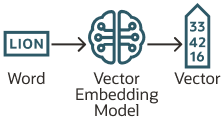The Future of Data Exploration: Oracle Database 23ai's Features Empower Oracle Analytics Cloud3/5/2024 Oracle recently made the latest version of their database: Oracle Database 23ai generally available, the next generation of its database incorporates a number of AI capabilities. There are over 300 new features in this new release and we'll be looking at some of these features from an Analytics perspective, empowering you to unlock deeper insights from your data. Some of the highlights of the Oracle Database 23ai release are discussed in this video below.  Converged Database Oracle Database 23ai is a Converged database which means that a single database can be used to store data in relational, graph, vector, spatial, JSON and several other formats. Here's how a converged database facilitates this: Unified Data Access: By storing and managing diverse data types within a single database system, a converged database eliminates the need for separate data silos and specialised databases for different workloads. This unified data access makes it easier to query, analyse, and generate insights across multiple data types without the overhead of complex data integration or movement between different systems. Consistent Data Governance: With all corporate data workloads stored in a converged database, it becomes easier to implement consistent data governance policies, security controls, and access management across the entire data landscape. This ensures data integrity, compliance, and proper access controls when generating insights from various workloads. Cross-Workload Analysis: A converged database allows you to perform cross-workload analysis by combining data from different sources and types. For example, you could analyse spatial data in the context of relational data, or enrich graph data with information from blockchain workloads. This cross-pollination of data can lead to more comprehensive and valuable insights. Unified Query Processing: By having a single query processing engine that can handle diverse data types, a converged database can optimise query execution and leverage advanced techniques like vectorisation, parallelisation, and indexing across different workloads. This can lead to faster and more efficient insight generation, especially for complex queries spanning multiple data types. Simplified Data Pipelines: Instead of maintaining separate data pipelines and ETL processes for each workload, a converged database allows you to streamline data ingestion, transformation, and analysis workflows, reducing complexity and potential sources of error. Improved Collaboration: With all corporate data workloads residing in a single converged database, it becomes easier for different teams and departments within an organisation to collaborate, share data, and generate insights collectively. This can foster better cross-functional analysis and decision-making. Future-Proofing: As new data types and workloads emerge, a converged database architecture can more easily adapt and incorporate them, future-proofing your data infrastructure and reducing the need for frequent migrations or replacements of specialised databases. AI Vector Search is another feature that can improve insights derived from your corporate data as it provides the functionality to access data in all the formats allowing foundation models like OpenAI's ChatGPT, Microsoft's Copilot, Anthropic's Claude to name a few to provide more accurate responses with access to all data in the Oracle Database 23ai.  AI Vector Search Another noteworthy feature introduced in Oracle Database 23ai is AI Vector Search. This functionality has the potential to significantly improve how users gain insights from their data. Unlike traditional keyword searches, AI Vector Search goes beyond simply matching terms. Instead, it focuses on understanding the underlying meaning and relationships within your data. This is achieved by converting text, images, and even relational data into mathematical representations that capture their essence. By comparing these representations, the database can identify information that aligns most closely with your query, regardless of its format or specific wording. This more semantic approach to searching unlocks new possibilities for data exploration within Oracle Analytics Cloud. Users can uncover previously hidden connections and patterns within their data, leading to a richer understanding and the ability to make more informed decisions. AI Vector Search is considered a significant benefit of a converged database when it comes to improving generated insights across a wide range of corporate workloads, including relational, spatial, graph, and blockchain workloads. Here's how AI Vector Search can enhance insight generation in a converged database environment: Unified Data Representation: By representing diverse data types as vectors, AI Vector Search allows for a consistent and unified representation of data across different workloads. This enables the application of machine learning and AI techniques consistently, regardless of the underlying data structure or format. Semantic Search: AI Vector Search leverages the power of vector representations to capture the semantic relationships between data elements. This enables more meaningful and context-aware searches, leading to better insights by retrieving relevant information based on conceptual similarity rather than just exact matches. Cross-Workload Similarity Analysis: With vector representations, AI Vector Search can identify similarities and patterns across different workloads, even if the data types are distinct. For example, it could uncover relationships between spatial data and graph data, or find connections between blockchain transactions and relational data, enabling novel insights and discoveries. Improved Query Performance: AI Vector Search typically uses specialised indexing techniques optimised for vector data, enabling faster and more efficient querying across large datasets spanning multiple workloads. This can significantly accelerate the process of generating insights, especially for complex analytical queries. Scalability: AI Vector Search can scale more efficiently than traditional search methods, as vector representations are typically more compact and can leverage techniques like dimensionality reduction. This scalability is crucial when dealing with the ever-increasing volumes of data across diverse corporate workloads. Integration with AI/ML Models: The vector representations used in AI Vector Search are compatible with many AI and machine learning models, enabling seamless integration of these advanced techniques for enhancing insight generation. For example, natural language processing models could be used to query and analyse text data across different workloads. I'd strongly recommend spending a bit of time taking this LiveLabs workshop to get an understanding of the vector data type basic principles.
Here's a breakdown of the steps to configure this setup: 1. Setting Up SharePoint Permissions:
By leveraging the AI Vector Search feature, the company can gain deeper and more nuanced insights from their data, leading to better-informed business decisions and a more responsive approach to customer feedback However, it's important to note that realising the full benefits of a converged database for generating insights across diverse workloads may require careful data modelling, performance optimisations, and leveraging the advanced analytical capabilities provided by the database system, such as machine learning, graph analytics, and spatial analysis functions. Conclusion
In conclusion, Oracle Database 23ai with its converged database architecture and AI Vector Search has the potential to unlock a new level of data exploration within Oracle Analytics Cloud. By storing all your corporate data, structured and unstructured, in a single platform, you can leverage the power of AI to search for insights across different data types using natural language. This not only simplifies data exploration and data integration for users but also empowers them to uncover hidden connections and patterns that might be missed with traditional keyword searches. As a result, Oracle Database 23ai paves the way for a more intuitive and insightful data analysis experience within Oracle Analytics Cloud, ultimately leading to better data-driven decision making.
0 Comments
Your comment will be posted after it is approved.
Leave a Reply. |
AuthorA bit about me. I am an Oracle ACE Pro, Oracle Cloud Infrastructure 2023 Enterprise Analytics Professional, Oracle Cloud Fusion Analytics Warehouse 2023 Certified Implementation Professional, Oracle Cloud Platform Enterprise Analytics 2022 Certified Professional, Oracle Cloud Platform Enterprise Analytics 2019 Certified Associate and a certified OBIEE 11g implementation specialist. Archives
May 2024
Categories |


 RSS Feed
RSS Feed

